Bisphosphonates cause osteonecrosis of the jaw-like disease in mice
- PMID: 20472893
- PMCID: PMC2893671
- DOI: 10.2353/ajpath.2010.090592
Bisphosphonates cause osteonecrosis of the jaw-like disease in mice
Abstract
Bisphosphonate-associated osteonecrosis of the jaw (BONJ) is a morbid bone disease linked to long-term bisphosphonate use. Despite its broad health impact, mechanistic study is lacking. In this study, we have established a mouse model of BONJ-like disease based on the equivalent clinical regimen in myeloma patients, a group associated with high risk of BONJ. We demonstrate that the murine BONJ-like disease recapitulates major clinical and radiographical manifestations of the human disease, including characteristic features of osseous sclerosis, sequestra, avascular, and radiopaque alveolar bone in the jaw that persists beyond a normal course of wound healing following tooth extraction. We find that long-term administration of bisphosphonates results in an increase in the size and number of osteoclasts and the formation of giant osteoclast-like cells within the alveolar bone. We show that the development of necrotic bone and impaired soft tissue healing in our mouse model is dependent on long-term use of high-dose bisphosphonates, immunosuppressive and chemotherapy drugs, as well as mechanical trauma. Most importantly, we demonstrate that bisphosphonate is the major cause of BONJ-like disease in mice, mediated in part by its ability to suppress osseous angiogenesis and bone remodeling. The availability of this novel mouse model of BONJ-like disease will help elucidate the pathophysiology of BONJ and ultimately develop novel approaches for prevention and treatment of human BONJ.
Figures
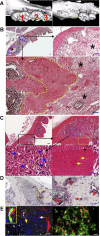
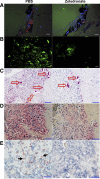
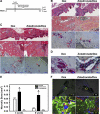
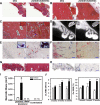

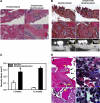
Similar articles
-
Differential impairment of vascularization and angiogenesis in bisphosphonate-associated osteonecrosis of the jaw-related mucoperiosteal tissue.Oral Surg Oral Med Oral Pathol Oral Radiol Endod. 2011 Aug;112(2):216-21. doi: 10.1016/j.tripleo.2011.02.028. Epub 2011 Jun 12. Oral Surg Oral Med Oral Pathol Oral Radiol Endod. 2011. PMID: 21664154
-
[Bisphosphonates and osteonecrosis of the jaw].Rev Stomatol Chir Maxillofac. 2008 Dec;109(6):367-73. doi: 10.1016/j.stomax.2008.09.008. Epub 2008 Nov 14. Rev Stomatol Chir Maxillofac. 2008. PMID: 19013624 Review. French.
-
Bisphosphonate-related osteonecrosis of the jaws: an update on clinical, pathological and management aspects.Head Neck Pathol. 2007 Dec;1(2):132-40. doi: 10.1007/s12105-007-0033-2. Epub 2007 Dec 5. Head Neck Pathol. 2007. PMID: 20614264 Free PMC article. Review.
-
Oral bisphosphonate therapy and osteonecrosis of the jaw: what to tell the concerned patient.Int J Prosthodont. 2007 Mar-Apr;20(2):115-22. Int J Prosthodont. 2007. PMID: 17455429
-
Updates on bisphosphonates and potential pathobiology of bisphosphonate-induced jaw osteonecrosis.Oral Dis. 2008 Apr;14(3):277-85. doi: 10.1111/j.1601-0825.2007.01381.x. Oral Dis. 2008. PMID: 18336375 Review.
Cited by
-
In vitro and in vivo studies using non-traditional bisphosphonates.Bone. 2020 May;134:115301. doi: 10.1016/j.bone.2020.115301. Epub 2020 Feb 26. Bone. 2020. PMID: 32112989 Free PMC article.
-
Pathophysiology of Osteonecrosis of the Jaws.Oral Maxillofac Surg Clin North Am. 2015 Nov;27(4):489-96. doi: 10.1016/j.coms.2015.06.001. Epub 2015 Sep 26. Oral Maxillofac Surg Clin North Am. 2015. PMID: 26412796 Free PMC article. Review.
-
Skeletal Site-specific Effects of Zoledronate on in vivo Bone Remodeling and in vitro BMSCs Osteogenic Activity.Sci Rep. 2017 Jan 31;7:36129. doi: 10.1038/srep36129. Sci Rep. 2017. PMID: 28139685 Free PMC article.
-
Associations between Systemic Markers of Bone Turnover or Bone Mineral Density and Anti-Resorptive Agent-Related Osteonecrosis of the Jaw in Patients Treated with Anti-Resorptive Agents.Yonago Acta Med. 2016 Mar;59(1):45-53. Epub 2016 Apr 1. Yonago Acta Med. 2016. PMID: 27046950 Free PMC article.
-
Combined zoledronic acid and meloxicam reduced bone loss and tumour growth in an orthotopic mouse model of bone-invasive oral squamous cell carcinoma.Vet Comp Oncol. 2015 Sep;13(3):203-17. doi: 10.1111/vco.12037. Epub 2013 May 8. Vet Comp Oncol. 2015. PMID: 23651067 Free PMC article.
References
-
- Bamias A, Kastritis E, Bamia C, Moulopoulos LA, Melakopoulos I, Bozas G, Koutsoukou V, Gika D, Anagnostopoulos A, Papadimitriou C, Terpos E, Dimopoulos MA. Osteonecrosis of the jaw in cancer after treatment with bisphosphonates: incidence and risk factors. J Clin Oncol. 2005;23:8580–8587. - PubMed
-
- Ruggiero SL, Woo SB. Bisphosphonate-related osteonecrosis of the jaws. Dent Clin North Am. 2008;52:111–128. - PubMed
-
- Kuehn BM. Reports of adverse events from bone drugs prompt caution. JAMA. 2006;295:2833–2836. - PubMed
-
- Woo SB, Hellstein JW, Kalmar JR. Systematic review: bisphosphonates and osteonecrosis of the jaws. Ann Intern Med. 2006;144:753–761. - PubMed
-
- Khosla S, Burr D, Cauley J, Dempster DW, Ebeling PR, Felsenberg D, Gagel RF, Gilsanz V, Guise T, Koka S, McCauley LK, McGowan J, McKee MD, Mohla S, Pendrys DG, Raisz LG, Ruggiero SL, Shafer DM, Shum L, Silverman SL, Van Poznak CH, Watts N, Woo SB, Shane E. Bisphosphonate-associated osteonecrosis of the jaw: report of a task force of the American Society for Bone and Mineral Research. J Bone Miner Res. 2007;22:1479–1491. - PubMed
Publication types
MeSH terms
Substances
Grants and funding
LinkOut - more resources
Full Text Sources
Other Literature Sources
Medical

